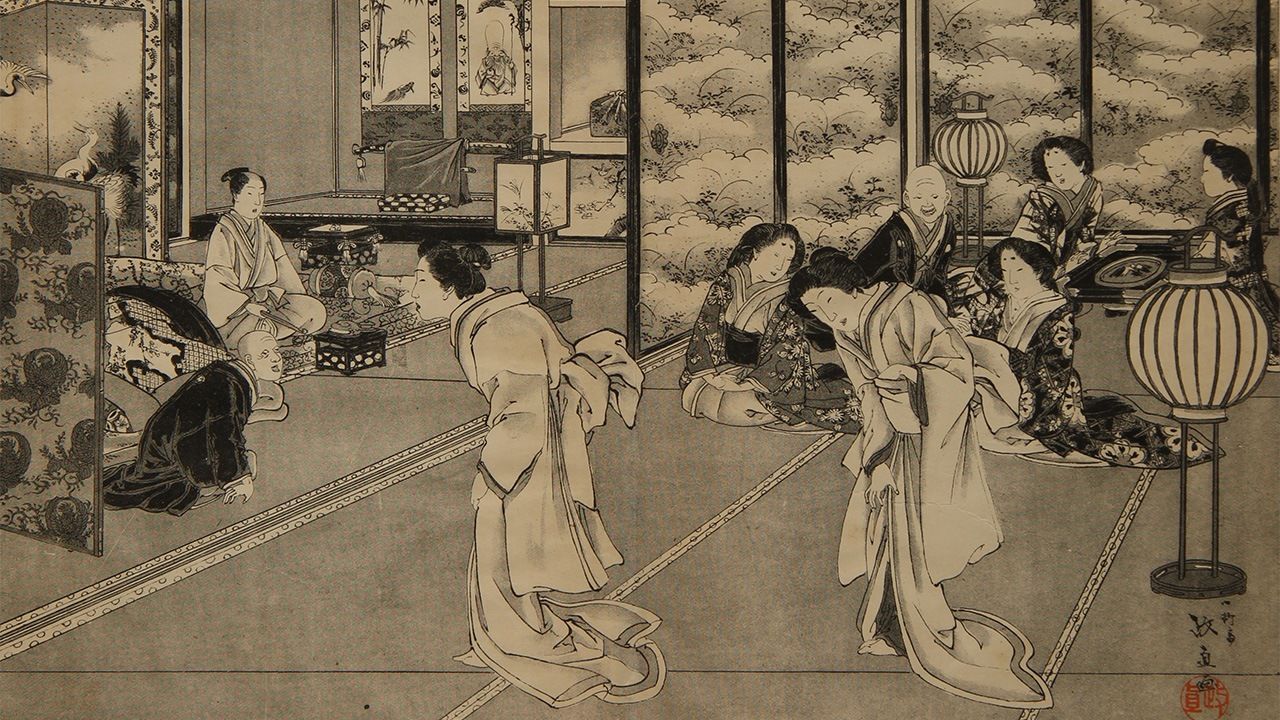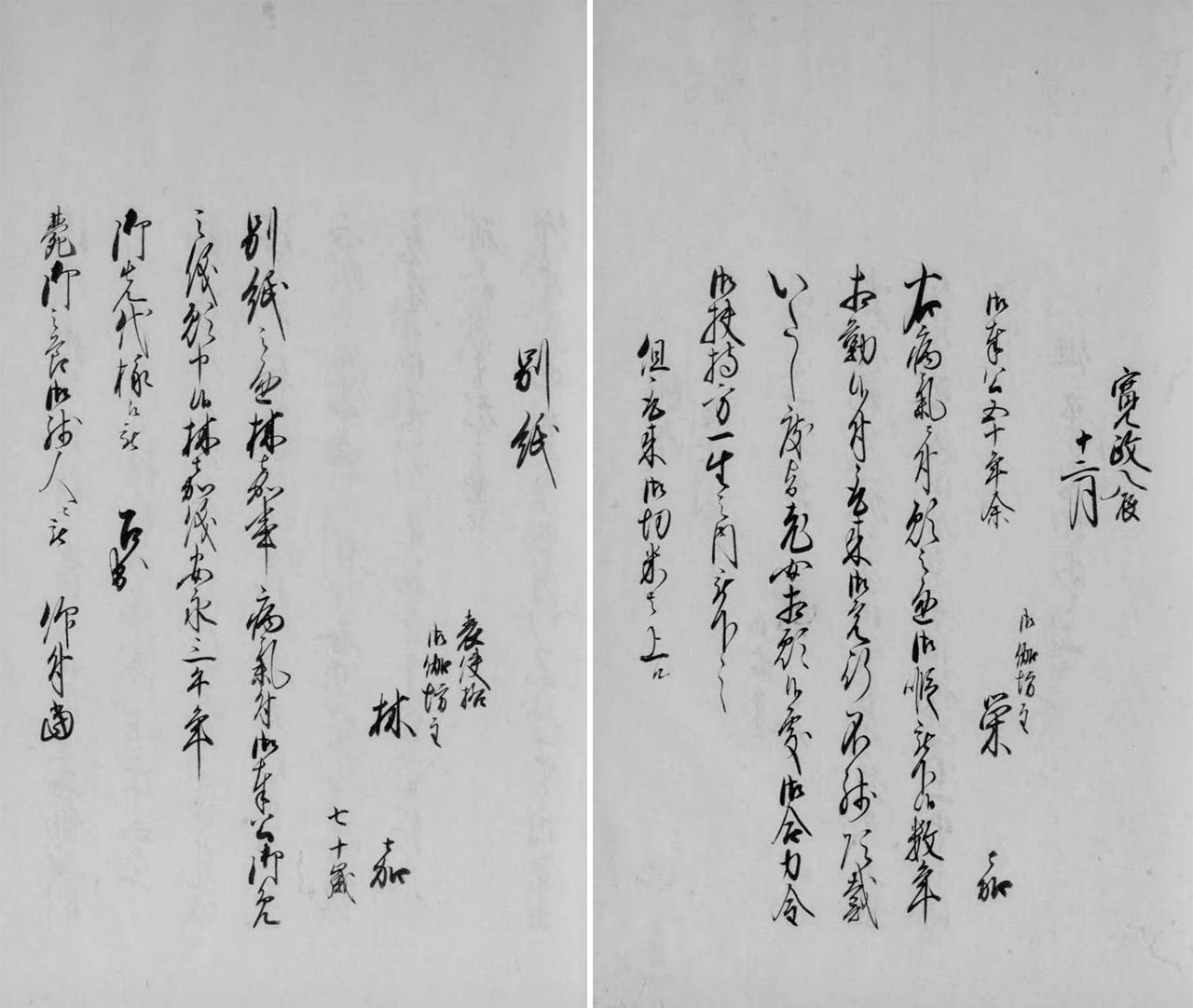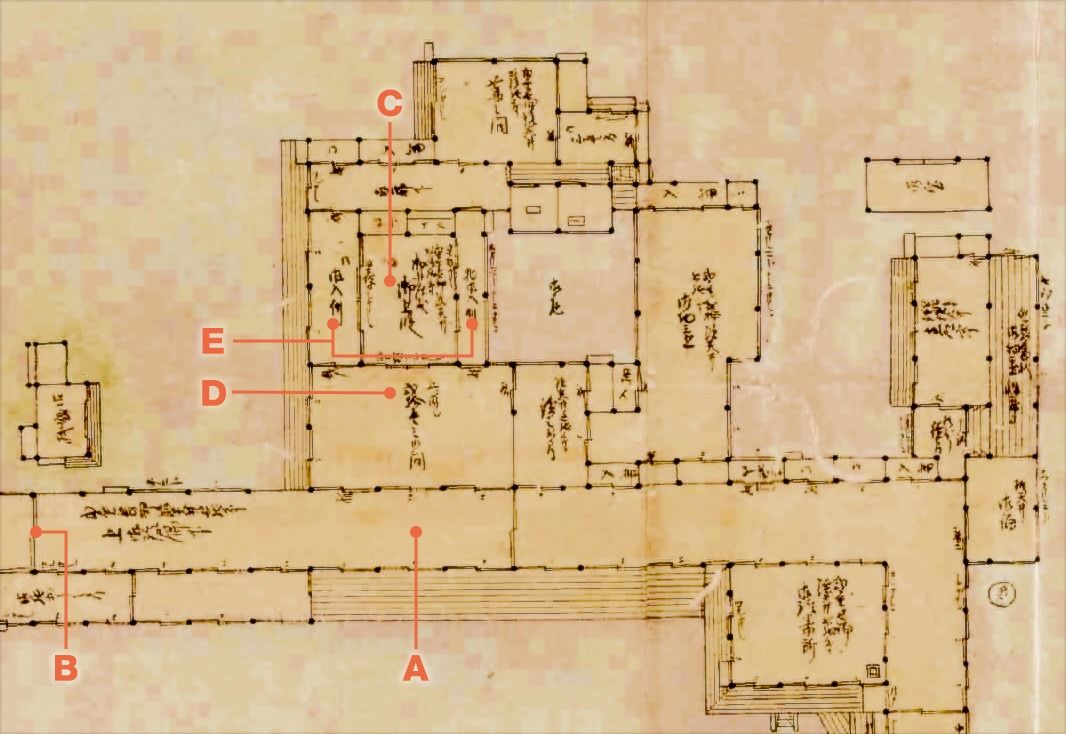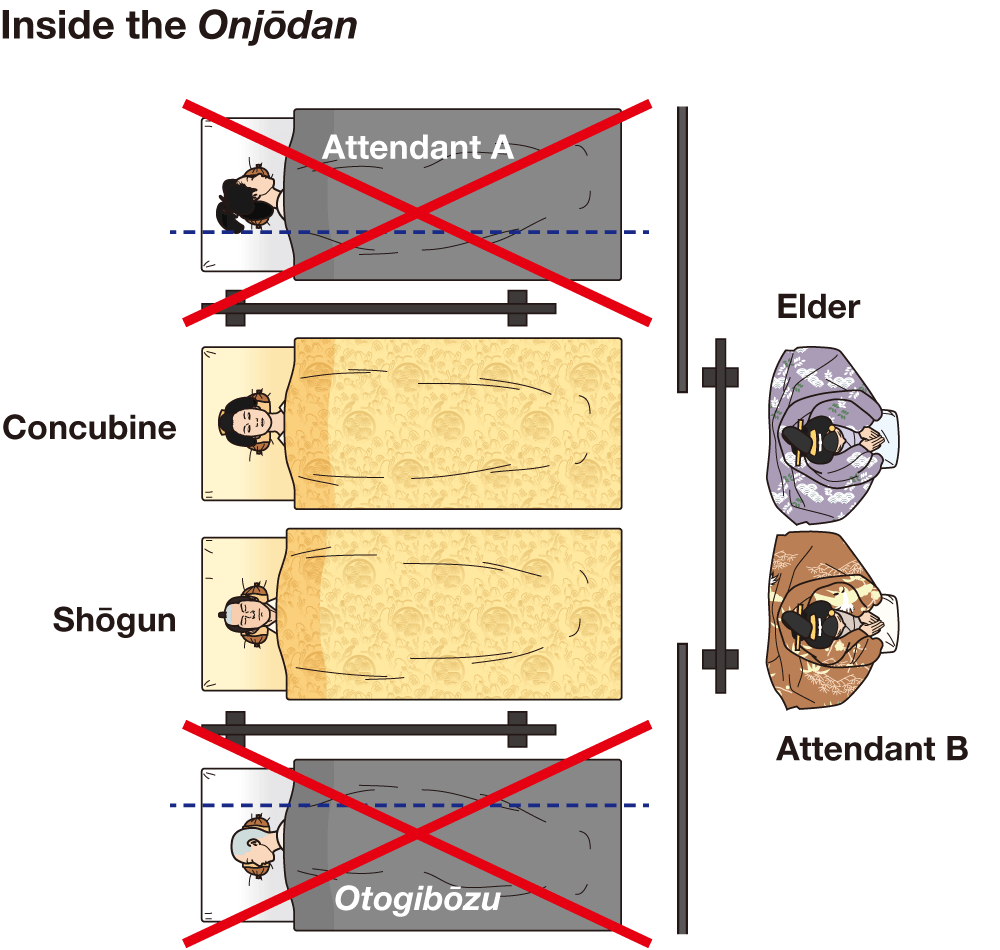
Palace Rendezvous: Rigid Rules Governed Sex Lives of Tokugawa Shōguns
History Culture- English
- 日本語
- 简体字
- 繁體字
- Français
- Español
- العربية
- Русский
Supervising the Shogunal Bedchamber
The intrigues of the Ōoku, the shōgun’s famed “inner chambers,” have long captivated the public imagination. Located inside the walls of Edo Castle, it contained the living quarters of women serving Tokugawa rulers and played a vital role in ensuring stability during the Edo period (1603–1868) through a system that fulfilled the political need for successors.
Many aspects of life in the Ōoku are shrouded in mystery, but works like Kyūji Shimonroku (Record of Inquiries into Bygone Days) compiled by a historical association at the former Tokyo Imperial University (now the University of Tokyo) help shed light on its inner workings. Based on interviews conducted in 1890–91 with former shogunal attendants and bakufu officials, the historical survey presents vivid, firsthand accounts of the daily life, rules, and customs of the living quarters.
Two of the more intriguing interviews contained in the work are with former ochūrō Minoura Hanako, a personal assistant to the shōgun and others, and junior maid Sassa Shizuko. Their accounts deal with the Ōoku from the time of the twelfth shōgun Tokugawa Ieyoshi (r. 1837–53) to the fifteenth and final ruler Tokugawa Yoshinobu (r. 1866–67).
The book Gotenjochū (Palace Maids) by Meiji-era researcher of Edo culture Mitamura Engyo and stories from servants published in the Tokyo daily Chōya Shimbun also offer valuable insight into the Ōoku.
Records like these that are based on subjective eyewitness accounts must be taken with a touch of skepticism as many details are unclear or hard to verify, but they still contain much that can be taken at face value. For instance, one account describes concubines being subject to rigorous physical search before bedding down with the shōgun. This seems likely amid the general air of security inside the Ōoku as a search would prevent any sharp object that could potentially serve as a weapon from being brought into the sleeping chamber. According to attendants’ statements, even ornate hairpins were forbidden.
Based on such accounts, it becomes apparent that the act of “entering the bedroom” was no passionate affair but called for careful preparations on the part of the concubine and attendants. Below is a simplified version of the procedure for visiting the shogun’s bedroom.
Step 1: Request by the shogun
The shōgun would first inform an attendant called an otogibōzu that he wished to visit the Ōoku. He would presumably also mention which of his concubines, who were typically chosen from among the ochūrō, he desired.
The otogibōzu were a special type of attendant. They were typically experienced, older women who were companions to high-ranked individuals, as signified by the character 伽 (togi), and served as liaisons within the Ōoku. They had shaved heads, as indicated by the term bōzu in their title, and dressed like priests (the figure in the black kimono at the right side of the banner image above is an otogibōzu).

Names and ages of otogibōzu appear in a list of servants from 1805–10. The left page records an attendant who was 70 years old and the right describes one who has “served for 50 years,” indicating that both were of advanced age. (Courtesy the National Archives of Japan)
Step 2: The concubine prepares
When chosen by the shōgun, a concubine would change into a white kimono and dress her hair, holding it in place with a kushi (comb) rather than the customary hairpin, as these were prohibited in the shogunal bedchamber.
Step 3: Entering the tsugi no ma
Dressed, a concubine would then move to the tsugi no ma, an antechamber adjacent to the bedroom, accompanied by an ochūrō, who would search her for forbidden items. These examinations appear to have been quite thorough, including probing the hair, which the concubine would then have to reset.
Step 4: Entering the bedchamber
The shōgun would be waiting for his concubine when she entered the onjōdan, a narrow, raised area of his personal apartment that served as the bedchamber. Personal attendants, the otogibōzu, and otoshiyori (the elder who ran the Ōoku) remained on guard nearby even after the couple settled down to their conjugal duties. This was to head off any attempt by the concubine to secure favors of the shōgun in the heat of the moment, such as a promise to make a male offspring the heir apparent.
Step 5: Reporting to the highest authority of the Ōoku
In the morning, the elder would make her customary report of the previous evening’s activities to the head of the Ōoku. If a pregnancy resulted from the encounter, this too would be closely monitored.
The occasions when the shōgun slept with the midaidokoro, his official wife, appear to have been less formalized, although attendants were still expected to keep an eye on events.
Okozashiki: The Shōgun’s Bedroom
The Nakaoku was the shōgun’s apartment inside the Ōoku, and his bedroom was called the okozashiki. The room opened onto two central corridors, the kami no osuzu rōka (upper bells corridor) and shimo no osuzu rōka (lower bells corridor), that connected the Nakaoku to other areas within the Ōoku. Below is a general explanation of the residence.

A map showing the shōgun’s living quarters inside Edo Castle (courtesy the Tokyo Metropolitan Library, Special Archives)
A. Kami osuzu rōka
The two osuzu rōka are well-known in Japan, having featured in numerous period dramas and movies depicting the Ōoku. The upper passage served as the main corridor connecting the shogunal apartment to the rest of the Ōoku. The lower passage was kept as an escape route following the devastating 1657 Great Fire of Meireki that burned large swaths of the capital, and later it was used as the passageway to the residence of the shōgun’s mother.
B. Kami osuzu rōka tobira
This was the entrance to the upper corridor. The doors of the two osuzu rōka were padlocked. When the shōgun passed along the upper corridor, the padlock was undone, the door opened, and a bell rung to herald his arrival.
C. Okozashiki onjōdan
The okozashiki was the central chamber of the shōgun’s residence inside the Ōoku. It had a raised inner room (onjōdan) that served as the bedchamber. When the shōgun met with a concubine, two sets of bedding with cushions were laid out in preparation.
D. Nijūjō no ma (Tsugi no ma)
This was a reception room that fronted the onjōdan and was separated by a screen.
E. Irikawa-en
These were verandas on the north and south sides of the onjōdan that were accessed via sliding doors. Also known as hiro-en (wide veranda) and tatami-rōka (tatami corridor), they were where servants and retainers waited.
New Insight into the Ōoku
Understanding of the Ōoku has been helped along in recent years by new findings, including several that have overturned previous assumptions. Notable among these are the discovery of drawings and other papers by carpenters involved in building the Ōoku.
It has long been assumed that when the shōgun spent the night with a concubine, a personal attendant (ochūrō) and elder sat on guard in the adjacent reception room. It was also presumed that another personal attendant and otogibōzu slept on either side of the amorous couple in the onjōdan to guard against any plotting on the part of the mistress.
However, the uncovered drawings cast the positions of this latter pair in doubt. According to the records, the onjōdan measured two ken in width, or 3.64 meters. Hirai Kiyoshi, an expert on feudal Japanese architecture, argues that such narrow confines would hardly have accommodated the two observers, who would have been blocked from laying out their bedding by the sliding doors. He notes that the only way they could have monitored the couple was by positioning themselves on the parallel verandas, but even then it would have been a tight fit as the southern irikawa-en was 1 ken (1.8 meters) wide and the northern one just half that.

New documents show that the shōgun’s bedroom would have been too narrow to fit everyone in the previously assumed sleeping arrangement. The dotted lines indicate the location of sliding doors. (Illustration by Satō Tadashi)
It is possible that the attendant and otogibōzu slept on either veranda; although separated from the onjōdan by sliding doors, this would still have enabled them to hear any conversation emanating from the sleeping chamber.
Former professor at the University of Tokyo’s Historiographical Institute, Yamamoto Hirofumi, offered an interesting twist to this surveillance system, noting that personal attendants standing guard were typically chosen among those who had previously shared the shōgun’s bed, presumably making them highly motivated to catch any illicit requests uttered by a rival lover.
Enduring such a constrained sex life is unthinkable to people today. But for shōguns, siring heirs was part of politics, and the lack of privacy in the bedroom was something to be endured.
(Originally published in Japanese. Banner photo: A scene from the Meiji-era graphic magazine Fūzoku Gahō depicting the sitting room inside the shōgun’s Ōoku apartment. Courtesy the Kokugakuin University Library.)